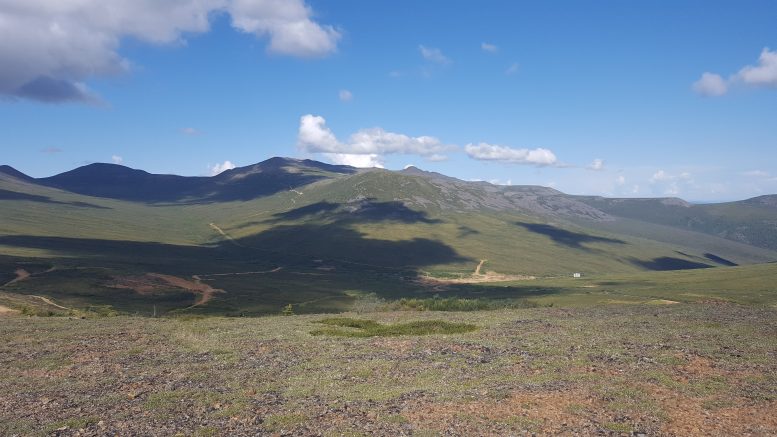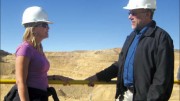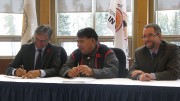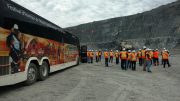WHITEHORSE, YUKON — The large scope of Western Copper and Gold’s (TSX: WRN; NYSE-MKT: WRN) proposed Casino mine in the Yukon Plateau is readily apparent during a flight into its well-established camp, 300 km north of Whitehorse.
Our small fixed-wing aircraft circles the heart of a large copper-gold-molybdenum porphyry deposit — marked by rolling hills topped by weathered bedrock — which could eventually host an open-pit extending over a 3 sq. km area and running 600 metres deep.

Western Copper and Gold’s Casino camp, 300 km northwest of Whitehorse, in west-central Yukon. Photo by Matthew Keevil.
Western Copper and Gold president and CEO Paul West-Sells then points to the location of a proposed tailings facility southeast of the envisioned open pit within a valley formed by the headwaters of Casino Creek.
Western Copper is permitting the first large-scale mining operation in the Yukon. This process has so far lasted almost three years, and the company is due to enter the official panel review, which it expects will last at least 24 months.
“There is definitely a degree of education that comes along with a project like Casino, and that’s especially true in a jurisdiction like the Yukon that hasn’t seen a development of this scope recently. We’ve spent time explaining the importance and opportunities represented by this type of mineral endowment, and how it can be developed responsibly,” West-Sells says.
“Casino can be a tremendous economic driver, but we need to consult effectively and communicate that the operation will be environmentally sustainable. At the same time, it’s necessary to understand that we aren’t reinventing the wheel here. There are many modern copper operations globally that are significantly larger,” he adds.

Western Copper and Gold president and CEO Paul West-Sells stands atop a hill overlooking the Casino copper-gold project camp. Credit: Western Copper and Gold.
The company completed a feasibility study on Casino, and submitted its project proposal to the Yukon Environmental and Socio-economic Assessment Board (YESAB) back in 2013. The proposed open-pit development would require US$2.5 billion in capital expenses and annually produce 171 million lb. copper, 266,000 oz. gold, 1.4 million oz. silver and 15.5 million lb. moly.
The model is based on proven and probable millable reserves (i.e. not counting heap-leachable reserves) of 965 million tonnes grading 0.2% copper, 0.24 gram gold per tonne, 0.023% moly and 1.74 grams silver per tonne. Total contained metal in the combined millable and heap-leach reserve is equal to 4.5 billion lb. copper, 8.9 million oz. gold, 483 million lb. molybdenum and 65 million oz. silver.
“When you look at the Yukon, perhaps the regulatory process takes a bit longer than you would prefer, but I believe it’s a process where if you follow the steps thoroughly you will end up getting through,” West-Sells continues over coffee in Casino’s dining hall.
“We’ve had to pay attention to our tailing facility due to its size, and we’ve addressed concerns from the jurisdiction and made adjustments according to that feedback. We spent a lot of time last year in the Yukon talking to First Nations and the government to explain what we’re doing about tailings.”
The Yukon’s only operating mine, Capstone Mining’s (TSX: CS; US-OTC: CSFFF) Minto operation, has a daily throughput of 4,000 tonnes per day. By comparison, Casino would feature a 120,000-tonne-per-day concentrator to produce copper-gold-silver and molybdenum concentrates. The development would also include a 25,000-tonne-per-day heap-leach component to produce gold and silver doré, and an on-site liquefied natural gas power plant.

An aerial view of Capstone Mining’s Minto copper-gold-silver mine in the Yukon, as seen in 2014. Credit: Minto Mining.
Western Copper has put together an independent tailings review panel to work through its design and incorporate alterations based on concerns voiced by First Nations, stakeholders and government.
In February 2016, the company was notified that Casino would require a federal panel review, which is the highest level of assessment carried out by YESAB. The company has spent the past year finalizing its environmental and socio-economic guidelines, which will underpin the beginning of the review process early next year.
At this point, Casino’s project application totals more than 14,000 pages of information and three years of engagement with regulatory agencies and various levels of government.
“The process passes over to the regulatory side once we submit our application at year-end, but up until that point all of the timelines are under our control,” West-Sells says. “We’ve moved through this process for a few years, so people are familiar with the project. We get the impression the regulators don’t want it to drag out any more than we do, and it should involve around a two-year review period.”

Looking down hill towards Western Copper and Gold’s mining camp at the Casino project. Photo by Matthew Keevil.
Western Copper has revised its tailings facility design to incorporate concerns surrounding the placement of “potentially acid-generating material” and the quantity of stored water, while it reviews more steps to lower Casino’s footprint by relocating project facilities.
The tailings management facility will be made from a dam built in the Casino Creek valley, while storing potentially acid-generating material underwater. The valley location would allow Western Copper to capture all run-off from the mine and mill site, and possibly prevent uncontrolled discharges to the environment and restrict drainage to a single point, away from the Yukon River.
West-Sells adds that the project could provide up to 1,000 direct jobs each year over the four-year construction period, and 600 jobs annually over the 22-year mine life.

Western Copper and Gold president and CEO Paul West-Sells in the core shack at the Casino copper project. Photo by Matthew Keevil.
Western Copper’s second major goal this year is to achieve a framework for project financing. The company has just over US$7 million in its treasury, and will likely require upwards of US$10 million through the permitting process.
Western Copper’s share price has rallied with copper prices over the past six months, gaining 60%, or 76¢, en route to a $2.02-per-share close at press time.
“It’s important to present a clear picture to the government and stakeholders of how Casino can be built in terms of the financing. We have a window right now since we’re making a few changes to the tailings design to line up capital opportunities,” West-Sells says during a walk across Western Copper’s shuttered camp.
“Capital partners tend to want to see something resembling the final design, and we’re approaching that point now. Our capital position is strong and we aren’t under pressure, but it’s always good to look at opportunities to increase that treasury.”





Be the first to comment on "Site visit: Western Copper approaches final mine design at Casino"